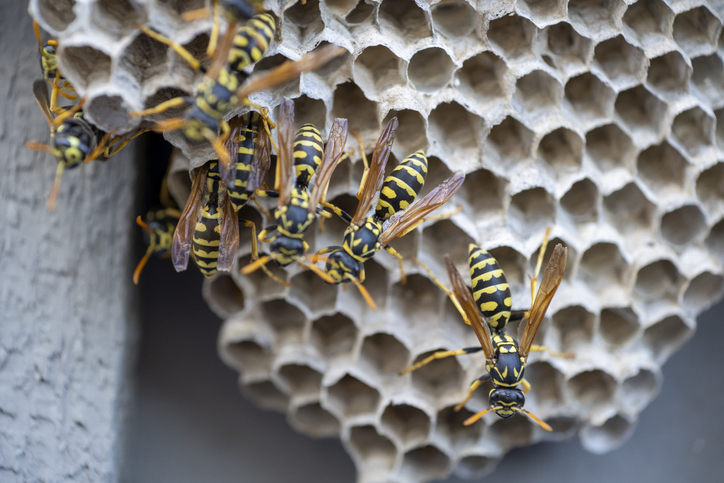Wasps vs. Bees
How can I Differentiate Between Wasps and Bees?
To differentiate between wasps and bees, observe their physical traits and behaviors. Bees have a more robust and hairy body, are generally less aggressive, and feed primarily on nectar and pollen. Wasps have slender, smooth bodies, are more likely to be aggressive, and have a varied diet, including other insects. Bees are also known for their wax hives, while wasps build paper-like nests.
Differentiating Between Wasps and Bees
Bees and wasps are often mistaken for each other, yet they play distinct roles in our ecosystem and require different handling strategies. As experts in pest control, Orkin understands the significance of identifying these insects correctly. This knowledge is not just crucial for effective pest management but also for appreciating the balance of nature.
Physical Differences: A Closer Look
Understanding the physical differences between bees and wasps is crucial for accurate identification, which in turn informs appropriate handling and control measures. Here’s a more detailed exploration of their distinct characteristics.

Save $50
on your first recurring service today with code GET50
Body Structure and Size
Typically, bees have a more robust and rounded body. They are covered in tiny hairs, which are essential for pollen collection. These hairs give them a somewhat fuzzy appearance. Bees tend to be smaller in size, with the common honeybee measuring about 15 mm in length.
Wasps, in contrast, have a slender, more streamlined body. They lack the dense hair found on bees, giving them a smoother and shinier appearance. Wasps can vary significantly in size, with some species like the common yellowjacket measuring around 12 mm, while others like the European hornet can grow up to 25 mm.

GET A PERSONALIZED QUOTE
To protect your home from pests, click here for a free pest control estimate. Our Orkin Pros will create a personalized pest treatment plan for your home or business
or Call (866) 249-0292
Color and Pattern
The coloration of bees is generally more subdued. They often exhibit a combination of black with a duller yellow or sometimes brown. The patterns are less distinct and can be obscured by their hair.
Wasps are known for their striking color patterns. They typically display bright yellow and black colors with well-defined, bold patterns. This vivid coloration is a warning sign to predators of their ability to sting.
Wings and Legs
Bees have two pairs of wings, with the hind wings smaller than the front ones. Their wings are more rounded at the tips. One of the most distinctive features of bees is their hind legs, which are flat and wide, adapted for collecting and carrying pollen.
Wasps also possess two pairs of wings but they are more slender and longer compared to bees. Their wings are often held tightly against their bodies when at rest. Wasps have slender legs, suited for their predatory and scavenging nature.
Antennae, Eyes and Stingers
Bees have antennae that are bent or “elbowed.” Their eyes are smaller and more rounded, adapted for their flower-visiting lifestyle. Wasps typically have straighter antennae. Their eyes are often larger and more elongated, aiding in their predatory activities.
Most bees have a barbed stinger, which means that when they sting, the stinger gets lodged in the skin of the victim, and the bee dies after stinging. This is particularly true for honeybees. Wasps have a smooth stinger, allowing them to sting multiple times without harming themselves. This feature makes them more formidable, especially when they feel threatened.
Behavioral Traits: More Than Just Buzzing Around
The behavior of bees and wasps is as varied as their physical appearance, and understanding these differences is key to not only identifying them but also appreciating their roles in the ecosystem. Let’s delve deeper into their distinct behavioral traits:
Nesting Habits
Bees are renowned for their complex social structures and hive-building skills. Honeybees, for instance, construct intricate wax hives, often located in protected areas like tree hollows or within man-made structures. These hives are a marvel of natural engineering, consisting of hexagonal cells that store honey and house their young. Bumblebees, on the other hand, often nest in the ground or in dense grass clumps, creating less structured nests.
Wasps exhibit a variety of nesting behaviors. Many, like yellowjackets and hornets, build paper-like nests made from chewed wood fibers mixed with saliva. These nests can be found hanging from trees, eaves, or buried underground. Unlike bees, wasp nests are not reused year after year. Some wasp species are solitary and do not build communal nests.
Diet and Foraging
Bees are primarily vegetarians, with a diet consisting of nectar and pollen from flowers. This diet is crucial for their role as pollinators. They have a mutually beneficial relationship with plants, as they transfer pollen from one flower to another, facilitating plant reproduction.
Wasps have a more varied diet. Many are predators, feeding on insects like caterpillars, flies, and even other bees. This makes them important natural pest controllers. Some species are also attracted to human foods, especially sweets and proteins, which often brings them into conflict with humans during outdoor activities.
Social Structure and Behavior
Most bee species are highly social, with a well-defined caste system consisting of a queen, workers, and drones. The queen is the only fertile female and is responsible for laying all the eggs in the hive. Workers, which are sterile females, perform various tasks like foraging, caring for the young, and maintaining the hive. Drones are males whose primary role is to mate with the queen.
Social structure among wasps varies widely. In species like yellowjackets and hornets, there is a similar caste system to bees, with a queen, workers, and males. However, many wasp species are solitary, with females living and breeding independently.
Aggression and Defense
Generally, bees are more docile and will sting only when provoked or to defend their hive. A bee’s sting is often a last resort, as it is fatal to the bee. Wasps can be more aggressive, particularly when defending their nests. They are more likely to sting in response to a perceived threat and can do so multiple times.
Seasonal Behavior
Bees are active during the warmer months and have different strategies for surviving the winter. Honeybees store honey in their hives to feed the colony through the cold season, while many wild bees hibernate. Wasps are also more active in warmer months. In autumn, as natural food sources decline, they become more aggressive and are often seen around human food. Most wasps do not survive the winter, except for fertilized queens who hibernate and start new colonies in the spring.
Understanding these behavioral traits not only helps in differentiating between bees and wasps but also highlights the importance of appropriate management strategies. At Orkin, we recognize the vital roles these insects play in our ecosystem and offer tailored solutions to manage them responsibly. Whether it’s a bee or a wasp issue, Orkin’s expertise ensures a balance between effective pest control and environmental care.
Orkin’s Approach to Bee and Wasp Control
At Orkin, we prioritize environmentally responsible methods to manage bees and wasps. Our team is trained to identify these insects accurately and recommend the best course of action, whether it be removal or relocation.
- Inspection and Identification – Our first step is always a thorough inspection to identify the specific type of bee or wasp, understanding their behavior and nesting habits.
- Customized Solutions – Depending on the species and the location of the nest, we offer tailored solutions that range from nest removal to more eco-friendly options like relocation for bees.
- Prevention Tips – We also provide advice on how to prevent future infestations, such as sealing entry points and reducing outdoor food sources.
Why Choose Orkin for Bee and Wasp Control?
Choosing Orkin means opting for a team that combines expertise with environmental consciousness. Our methods are not only effective but also consider the important role these insects play in our ecosystem.
Frequently Asked Questions
What are the main physical differences between bees and wasps?
Bees have a robust, hairy body, while wasps have a slender, smooth body.
How do bees and wasps differ in their nesting habits?
Bees build wax hives, often in protected areas, while wasps create paper-like nests, sometimes in open spaces.
Are bees or wasps more aggressive?
Wasps are generally more aggressive, especially when defending their nests.
What do bees eat compared to wasps?
Bees primarily consume nectar and pollen, whereas wasps have a more varied diet, including other insects.
Can both bees and wasps sting multiple times?
Wasps can sting multiple times, but bees usually sting once as they have a barbed stinger.
How can I safely identify a bee or wasp?
Observe from a safe distance, noting body shape, size, and nest type without disturbing them.
Do bees and wasps play different roles in the ecosystem?
Yes, bees are crucial for pollination, while wasps are important as natural pest controllers.
Should I remove a bee or wasp nest on my own?
It’s safer to contact pest control professionals like Orkin for safe and responsible removal.
Conclusion
Differentiating between bees and wasps is a valuable skill that enhances our understanding and appreciation of nature. Recognizing their distinct physical characteristics and behaviors not only aids in avoiding unwanted encounters but also in appreciating the vital roles these insects play in our ecosystems. Bees, with their pollination activities, and wasps, as natural pest controllers, both contribute significantly to the balance of our environment.
When faced with a bee or wasp issue, it’s important to handle it with care and respect for these creatures. Orkin offers expert services in managing these insects, ensuring safe and environmentally responsible solutions. Remember, the next time you encounter a buzzing insect, take a moment to observe and appreciate its role in our world. And if you need assistance, Orkin is just a call away, ready to provide expert advice and service.

FIND YOUR LOCAL BRANCH
To protect your home from pests, click here for a free pest control estimate. Our Orkin Pros will create a personalized pest treatment plan for your home or business
or Call (866) 249-0292

